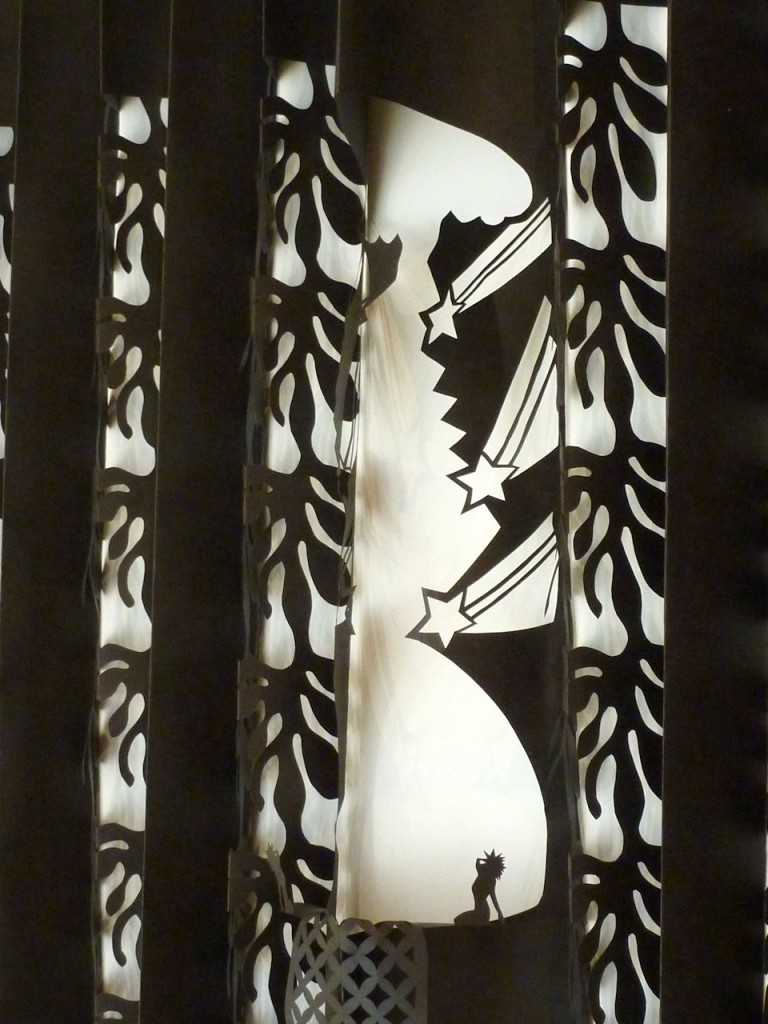
The Dowse’s retrospective of Lonnie Hutchinson’s most recent 27 years of work, relishes the production of three dimensions out of two.
But it is not only this manufacturing of space which means the exhibition is of interest to architects. The medium of the spatial production of folds and cast shadows is primarily building paper, which pays “homage to Pacific women and their traditional arts such as siapo, tivaevae and weaving.” These folded and cut sheets establish the scale and reference for the exhibition; the vertical hangings of She Could Taste Salt on her Lips (2007), Milk and Honey (2012), and Waiting for Le Ma’oma’o (2012) providing the pace, rhythm and themes, which the other works elaborate.

Exploring issues of sexual and racial politics, Hutchinson’s work explores difficult subjects, including enslaved prostitution (Black Pearl (2004)), “the discord between western and indigenous perceptions of beauty” (Comb (2009)), and representations of the indigenous female body (Can You See Me? (1997)). Yet the clean sharpness of the handiwork, mimicking an hygienic mass production, means that it is easy to be seduced (and blinded) by the cleverness of the pattern-making and the detail of the decorative.

Aeroplane lollies collaborate to form the shape of an aeroplane in Lole Lole (2003) – appended with a note warning that the lollies are coated “in a toxic substance.” Giant hair combs are adorned with female cutout figures with unruly hair in Comb (Red) (2009) and Comb (White) (2009)).

Folded black building paper, mimicking enlarged hankerchieves or serviettes (Sista Girl (2004)) reference “the cultural significance of lace in Samoan culture as a form of beautification of the home and the body.” They appear in v-formation, seemingly predicting Brett Graham’s equally political and decorative Te Hokioi (2008) – a carved American F117 Nighthawk stealth fighter jet which references the 2007 police raid on Ruatoki.

Like Comb, Sista Girl, and Milk and Honey, Waiting for Le Ma’oma’o (2012) uses the cutout to create silhouettes, an eighteenth-century art form used to create portraits through the outline of a person’s profile.

These were particularly associated with women, and many hung in parlours throughout the length of England. More recently cutouts featured in the work of Richard Killeen, though often as plan views of insects and object, rather than profiles of people. They were largely surpassed with the invention of photography.

Waiting for Le Ma’oma’o introduces scale shifts to the elegant shape-making and shadow-casting, situating miniature women within elaborate scenes are shifting pattern, reminisent of a James Bond opening title, where guns, and bullets are intricately adorned with miniature women and fantasy.

Hutchinson’s work has fewer ornamental female figures, yet the insinuated phallic references, and the psychodelic (even if monochromatic) form-making of the consequent shadow-play evokes the sexualisation of the female body that the Bond phenomenon is of course reknown for.


One figure though, despite a diminutive size, is clearly clothed.

She contrasts others whose poses recall images of exotic maidens. Instead she stands: long hair, long skirt, as artist photographing (and representing) the work itself.

The official explanation for the work differs. It describes the artist photographing the night skies of Samoa in July 2012, following the devastation of the 2009 tsunami. Personally I am partial to the luscious dodginess of Bond film graphs being stealthily co-opted for Hutchison’s feminist purposes.
Black Bird is on until 15 November 2015

Leave a Reply